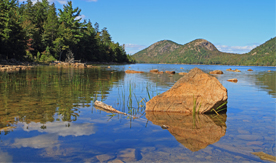It’s Clear: Water Clarity Is Declining

Water clarity, a strong indicator of water quality, is deteriorating in Maine lakes, according to a University of Maine graduate student’s study.
The decline, says Ian McCullough, may be a trend toward eutrophication — a process in which excess nitrates and phosphates, generally due to fertilizers and sewage, stimulate growth of algae, which depletes oxygen in the water.
Using satellite-based remote sensing, McCullough found a decrease in average statewide lake clarity from a depth of 4.94 meters in 1995 to 4.38 meters in 2010.
Water clarity, he says, ranged from 4 to 6 meters during the time frame, and consistently worsened from 2005 to 2010.
McCullough divided the state, which has more than 5,500 lakes and ponds larger than 10,000 square meters, into three regions: northeastern, south-central and western. He assessed data from 547 lakes for the study.
McCullough found lakes with reduced clarity occurred disproportionately (in 52 of 63 lakes) in larger lakes in the remote northeastern and western regions. Clarity in these two regions decreased from 5.22 meters in 1995 to 4.36 meters and 4.21 meters, respectively, in 2010.
Climate changes that impact algal growth and changes in forest cover due to timber harvesting may have contributed to the disproportionate decline in these regions, he says.
Meanwhile, lake clarity in the south-central lake region remained at 4.50 meters from 1995 to 2010 and lakes with improved clarity occurred most often in this region (in 52 of 72 lakes).
The proportion of eutrophic lakes (those with excessive nutrients and dominated by aquatic plants and algae) increased from 35.3 percent in 1995 to 42.6 percent in 2010. While the proportion of mesotrophic lakes (medium levels of nutrients and a high diversity of plants and animals) was unchanged, the proportion of oligotrophic lakes (lacking in plant nutrients and having an abundance of dissolved oxygen) decreased from 14.8 percent in 1995 to 6.8 percent in 2010.
Taken together, McCullough says these results suggest a general trend toward eutrophication in Maine lakes.
Although the results are potentially discouraging, McCullough says individual property owners and lake associations can employ various mitigation strategies. They include enhancing or restoring shoreline buffers with native vegetation, updating septic systems in lakeshore homes, controlling invasive species and minimizing impervious surfaces in lake watersheds.
In addition, statewide programs such as LakeSmart and the Maine Volunteer Lake Monitoring Program already partner with local lake associations to educate and engage people about protecting and restoring healthy lake ecosystems.
McCullough, who earned his master’s in ecology and environmental science at UMaine, is a graduate student researcher at University of California, Santa Barbara.
His study is titled “Landsat imagery reveals declining clarity of Maine’s lakes during 1995–2010.” Co-authors are Cynthia Loftin, a UMaine associate professor and leader of the U.S. Geological Survey, Maine Cooperative Fish and Wildlife Research Unit; and Steven Sader, UMaine professor of forest resources.
The Society for Freshwater Science published the study online in June 2013.
Contact: Beth Staples, 207.581.3777
